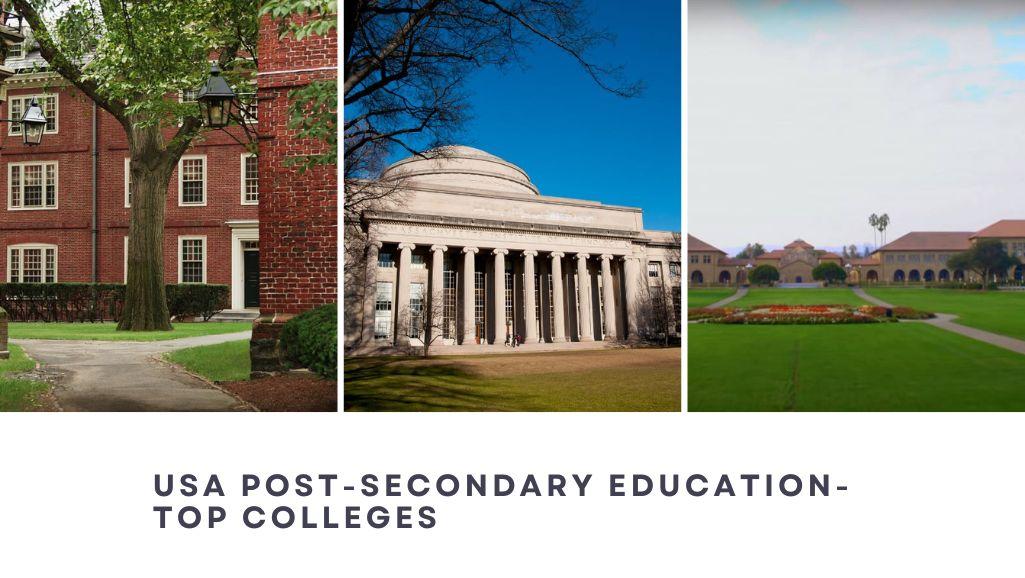The journey from secondary to USA Post-Secondary Education is a transformative experience, offering a diverse range of options for students to carve out their academic futures. This comprehensive approach opens doors for personal growth, specialization, and a broader understanding of subjects. As we delve into the USA’s post-secondary education landscape, we’ll uncover renowned colleges, understand the education levels, explore the adaptable syllabus, and learn how grades work.
Top Colleges in the USA

Harvard University: Pioneering Intellectual Inquiry
Harvard University, an example of academic distinction, epitomizes the essence of top-tier education. With a diverse range of disciplines spanning sciences, humanities, and social sciences, Harvard consistently pushes the boundaries of intellectual inquiry. Its legacy of groundbreaking research, Nobel laureates, and influential alumni underscores its impact on global knowledge advancement.
- Distinguished Faculty: Harvard’s faculty includes leaders in various fields, fostering an environment of mentorship and groundbreaking research.
- Interdisciplinary Synergy: The university encourages cross-disciplinary collaboration, allowing students to explore beyond traditional boundaries.
- Research Opportunities: Students have access to state-of-the-art facilities and resources, fostering innovation and exploration.
Massachusetts Institute of Technology (MIT): Forging Technological Frontiers
MIT, renowned globally for its focus on science, engineering, and technology, stands as a haven for aspiring innovators. Through hands-on learning, cutting-edge laboratories, and a commitment to technological advancement, MIT shapes students into forward-thinking problem solvers.
- Hands-On Learning: MIT’s emphasis on practical application enables students to translate theoretical concepts into real-world solutions.
- Entrepreneurial Spirit: MIT cultivates an entrepreneurial ecosystem, encouraging students to bring their ideas to market.
- Innovation Culture: From robotics to artificial intelligence, MIT consistently leads in groundbreaking research and technological advancements.
Stanford University: Fostering Innovation and Entrepreneurship
Nestled in the heart of Silicon Valley, Stanford University is a hub of innovation and entrepreneurship. With a blend of liberal arts and sciences, Stanford nurtures creative thinking and equips students with the skills to navigate a rapidly evolving world.
- Interdisciplinary Approach: Stanford’s “plus” courses enable students to combine diverse subjects, fostering adaptable thinking.
- Real-World Impact: Stanford encourages projects that have real-world applications, contributing to societal progress.
- Global Network: Its location in a tech-centric ecosystem connects students with industry leaders, creating unparalleled opportunities.
Overview of the USA Education System Levels
The American education system operates across a multi-tiered framework that guides students through distinct phases of academic and professional development. Each level of the education system is designed to provide students with the knowledge, skills, and experiences needed to excel in their chosen fields.
Undergraduate Level: Exploration and Foundation
At the undergraduate level, students embark on a journey of exploration and self-discovery. This phase is characterized by a diverse curriculum that encourages them to engage with a wide range of subjects. By offering introductory courses from various disciplines, universities empower students to develop a holistic understanding of the world around them. This period fosters critical thinking, effective communication, and a strong foundation upon which further specialization can be built.
Graduate Level: Specialization and Expertise
Building upon the knowledge acquired during undergraduate studies, graduate programs allow students to hone their expertise in specific areas. These programs offer a deeper exploration of subjects, often involving advanced coursework, research projects, and collaborations with esteemed faculty members. Graduate students engage in critical analysis, independent research, and the development of innovative solutions to complex challenges. This level prepares individuals for leadership roles, research contributions, and specialized careers.
Professional and Doctoral Programs: Advancement and Innovation
The pinnacle of the American education system is reached through professional and doctoral programs. These advanced degrees are tailored for individuals who aspire to contribute significantly to their fields through groundbreaking research, advanced scholarship, and the application of knowledge to real-world problems. Doctoral programs, in particular, emphasize original research that pushes the boundaries of existing knowledge. Graduates of these programs become thought leaders, pioneers, and experts who drive innovation, shape policy, and shape the future trajectory of their respective disciplines.
Detailed Syllabus Insights
- Customizable Majors and Courses: Students can select majors and courses that resonate with their interests, fostering a sense of ownership over their education. This personalization enhances engagement and the acquisition of knowledge.
- Interdisciplinary Opportunities: The emphasis on interdisciplinary learning transcends conventional boundaries, encouraging students to integrate knowledge from diverse fields. This approach cultivates well-rounded individuals with a holistic perspective.
- Real-World Application Focus: The curriculum is designed to equip graduates with practical skills relevant to their chosen industries. This emphasis on real-world applications enhances graduates’ readiness for professional roles.
Grading and Marks Distribution in USA Post-Secondary College
In the USA Post-Secondary Education, the grading system is a fundamental component of the education process, providing a comprehensive assessment of a student’s performance and understanding.
Letter-Based Grading System:
The letter-based grading system is a hallmark of the USA Post-Secondary Education system.
- A: Represents exceptional performance, indicating a thorough understanding of the material and a high level of proficiency. For instance, an “A” grade corresponds to a numerical score of 90% or above.
- B: Indicates a strong performance, reflecting a solid grasp of the subject matter and a good level of competency. Generally, a “B” grade corresponds to a numerical score ranging from 80% to the upper 80s.
- C: Suggests a satisfactory performance, demonstrating a basic understanding of the material. This grade corresponds to a numerical score ranging from the mid-70s to the upper 70s.
- D: Represents a minimal passing grade, suggesting a marginal understanding of the material. In some cases, a “D” may not be considered a passing grade and might not be accepted as credit toward a major.
- F: Indicates a failing grade, suggesting a lack of understanding or inadequate effort in the course. An “F” grade signifies a numerical score below a specific threshold, often 60% or 65%.
Assessment Factors:
- Class Participation: Active engagement in classroom discussions, group activities, and practical exercises.
- Assignments: Completion of individual or group assignments that test understanding and application of concepts.
- Projects: Submission of comprehensive projects that often require independent research, critical thinking, and creativity.
- Quizzes and Midterms: Regular assessments that gauge a student’s grasp of the ongoing coursework.
- Final Exams: Comprehensive assessments conducted at the end of a semester or course, covering all material taught.
Grading Variation and Context:
It’s important to note that while the letter-based grading system is widely used, the exact grading criteria can vary from one institution to another. For instance, some colleges may implement a “+/-” system, where grades like “A-” or “B+” offer additional granularity. Grading policies can differ based on the level of difficulty of the course, departmental standards, and the overall academic culture of the institution.
How Do You Apply for a USA Post-Secondary College?
Applying for a Post-Secondary College in USA Post-Secondary Education is an exciting yet multi-faceted process that requires careful planning, research, and attention to detail.
Research and Selection:
Before embarking on the application process, it’s crucial to conduct thorough research to identify colleges that align with your academic goals, interests, and values. Consider factors such as program offerings, faculty expertise, campus culture, location, and available resources. This research lays the foundation for creating a well-informed list of colleges to which you will apply.
Standardized Tests and Requirements:
Most colleges require standardized test scores as part of the application. The SAT and ACT are common exams that assess your readiness for college-level work. Research the specific tests required by the colleges on your list and prepare diligently. Additionally, gather other essential documents, such as transcripts, letters of recommendation, and essays.
Application Platforms:
Many colleges in the US use centralized application platforms such as the Common Application or the Coalition Application. These platforms streamline the application process by allowing you to apply to multiple colleges using a single application form. This saves time and effort while ensuring consistency in your application materials.
Personal Statement and Essays:
Colleges often require personal statements and essays that provide insight into your character, experiences, and aspirations. Take this opportunity to showcase your unique qualities, achievements, and the reasons you are a great fit for the college. Craft compelling narratives that demonstrate your passion, resilience, and potential contributions to the campus community.
Letters of Recommendation:
Letters of recommendation offer an external perspective on your abilities and potential. Select recommenders who know you well and can speak to your academic achievements, character, and potential for success in college. Give your recommenders ample time to write strong, personalized letters that add value to your application.
Financial Aid and Scholarships:
If you require financial assistance to attend college, research the financial aid and scholarship options offered by the colleges on your list. Many institutions provide scholarships based on merit, talent, or need. Familiarize yourself with the deadlines and requirements for applying for financial aid.
Submission and Deadlines:
Carefully note the application deadlines for each college. Early Decision, Early Action, Regular Decision, and Rolling Admission are some of the application options offered. Plan your application timeline to ensure that you submit your materials well before the deadline to avoid any last-minute issues.
Follow-Up and Interviews:
As part of the application process, certain colleges may provide interviews. If given the opportunity, take advantage of interviews to express your enthusiasm for the college and provide additional insights into your personality and goals.
The USA Post-Secondary Education System encompasses a dynamic and diverse landscape, with institutions like Harvard, Stanford, and MIT at its forefront. This system provides students with a multi-level approach to learning, enabling them to deepen their expertise and contribute to their fields. The malleable syllabus empowers students to curate their educational experiences, fostering adaptability and innovation. Grading practices encapsulate a holistic evaluation of students, highlighting their knowledge and dedication.
Also, Read: What is Scaffolding in Education?







